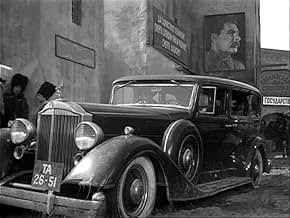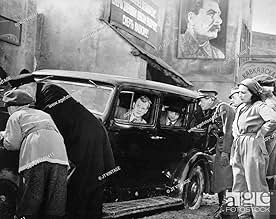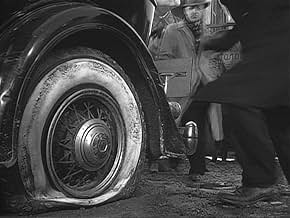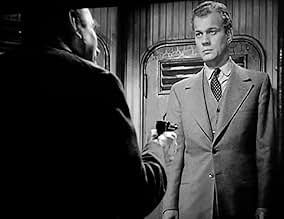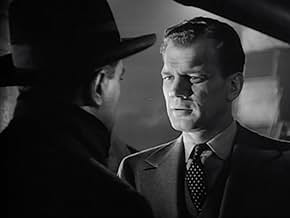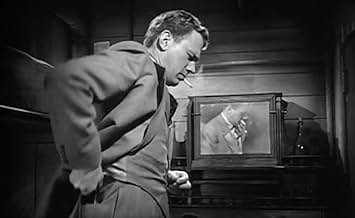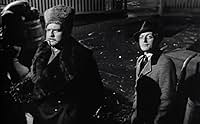IMDb-BEWERTUNG
6,5/10
4981
IHRE BEWERTUNG
Füge eine Handlung in deiner Sprache hinzuAn American ballistics expert in Turkey finds himself targeted by German agents. Safe passage home by ship is arranged for him, but he soon discovers that his pursuers are also on board.An American ballistics expert in Turkey finds himself targeted by German agents. Safe passage home by ship is arranged for him, but he soon discovers that his pursuers are also on board.An American ballistics expert in Turkey finds himself targeted by German agents. Safe passage home by ship is arranged for him, but he soon discovers that his pursuers are also on board.
Dolores Del Río
- Josette Martel
- (as Dolores Del Rio)
Anna De Linsky
- Russian Maid at Batumi Hotel
- (Nicht genannt)
Jerome de Nuccio
- Turkish Officer
- (Nicht genannt)
Herbert Drake
- Ship's Steward
- (Nicht genannt)
Empfohlene Bewertungen
Well it says Journey Into Fear was directed by Norman Foster, but many sources say it was actually Orson Welles who directed it. Possible of course since this Mercury Theatre production was produced, co- written {with co-star Joseph Cotton} and starred big Orson himself. But wait! Welles is on record as saying he did no directing on the film and it was his friend Foster in the chair. Except for Welles' own scenes which were directed by anyone handy since they were rushing because Welles was due in Brazil to film It's All True! There has also been re-cuts by Welles, added scenes and a narration at the beginning and end that has been and gone over the years. It's all appropriate confusing conjecture tho since the film itself has a strange quirkiness nestling within its arresting visuals.
The story is based on Eric Ambler's highly regarded spy thriller, and sees Howard Graham {Joseph Cotton} as an American engineer, who after a conference in Turkey finds that someone is trying to kill him. We are then thrust into a murky world of espionage where everybody, their motives, and their identities are suspect. Graham is the classic innocent man abroad, we the viewers, as well as everyone in the story but Graham, knows more than he does! I bet Hitchcock loved this film for it be right up his alley. The majority of the film takes place aboard a cramped dilapidated liner, this gives off a wonderfully claustrophobic feel to proceedings. The stifling nature further enhanced by the fact that 99% of the film is set at night time, with Karl Struss' photography utilising shadows and exuding an almost bizarre menacing sheen. There's some nice technical Welles trademarks in here, such as crane shots {the opening scene is moodily awesome} and Welles' well publicised love of magic is given a cute nod during one particularly impacting sequence.
Along side Cotton the cast contains solid performers like Dolores del Rio, Everett Sloane, Ruth Warwick and Agnes Moorehead. But it's Cotton who rightly makes the big impact. Understated and quiet, his Howard Graham infuriates with his inability to grasp what is going on, or to act at times when it clearly calls for the swift clank of brain being put into gear. A real smart bit of casting here from Foster, Welles or whoever! Journey Into Fear, for texture and technical composition belongs in the film-noir genre, certainly as far as the early cycle goes. But really it's a film for the general cinema purists, at times brilliant, at others chaotic, it remains engrossing from start to finish. See it if you can. 8/10
The story is based on Eric Ambler's highly regarded spy thriller, and sees Howard Graham {Joseph Cotton} as an American engineer, who after a conference in Turkey finds that someone is trying to kill him. We are then thrust into a murky world of espionage where everybody, their motives, and their identities are suspect. Graham is the classic innocent man abroad, we the viewers, as well as everyone in the story but Graham, knows more than he does! I bet Hitchcock loved this film for it be right up his alley. The majority of the film takes place aboard a cramped dilapidated liner, this gives off a wonderfully claustrophobic feel to proceedings. The stifling nature further enhanced by the fact that 99% of the film is set at night time, with Karl Struss' photography utilising shadows and exuding an almost bizarre menacing sheen. There's some nice technical Welles trademarks in here, such as crane shots {the opening scene is moodily awesome} and Welles' well publicised love of magic is given a cute nod during one particularly impacting sequence.
Along side Cotton the cast contains solid performers like Dolores del Rio, Everett Sloane, Ruth Warwick and Agnes Moorehead. But it's Cotton who rightly makes the big impact. Understated and quiet, his Howard Graham infuriates with his inability to grasp what is going on, or to act at times when it clearly calls for the swift clank of brain being put into gear. A real smart bit of casting here from Foster, Welles or whoever! Journey Into Fear, for texture and technical composition belongs in the film-noir genre, certainly as far as the early cycle goes. But really it's a film for the general cinema purists, at times brilliant, at others chaotic, it remains engrossing from start to finish. See it if you can. 8/10
Not the noir masterpiece we've come to expect with the likes of Welles and Cotton in the cast, but still an engaging film with cleverly shot scenes, witty dialog, and suspense. Joseph Cotton plays Howard Graham; an American armaments engineer in the midst of a deal designed to supply Turkey, a U.S. ally, with weapons to fight the axis. The axis, in particular the nazi's, have other ideas and are determined to prevent Graham from reaching the shores of the U.S. to seal the deal. During a magician's act at a club in the heart of Istanbul, a hit man mistakenly kills the magician instead of graham - or was it really a mistake? Graham is immediately questioned by the head of the Turkish secret police Colonel Haki (played with joyful exuberance by Welles) and for his protection, and the interests of the Turkish military, is put on a ship deemed the "safest" route back to the U.S. Of course this is not the case and the ship is filled with a cast of menacing characters, many not what or whom they seem. JOURNEY INTO FEAR is most enjoyable for its humorous subplots that are eluded to, but never explicitly. When Graham had to suddenly disappear he left behind a wife, and Colonel Haki has taken upon himself the duty to inform her of the crisis but elects to mislead, indirectly suggesting that Graham is a womanizer, with the possible objective to seduce her in this weakened state. "What's to become of me?" She asks. "We'll think of something." Is Haki's coy reply. And so it goes.
Joseph Cotten plays an American armaments engineer on the run from the Nazis in "Journey into Fear," a 1943 film with a script by Cotten (from a story by Eric Ambler) and costarring Orson Welles and Delores del Rio. Cotten is working on a deal to supply Turkey with weapons to fight the Axis. The Nazis don't want the deal made and are trying to stop Cotten from getting back to the U.S.
There are some very exciting scenes in this extremely atmospheric film, in particular on the ledge of a building between Cotten and the terrifying assassin. Most of the film takes place on board a dingy ship where Cotten is taken, thus beginning his Kafka-esquire nightmare.
This is an entertaining film for sure, but I've always been troubled by it. First of all, it seems like there are scenes missing. Second, it's on the confusing side since there are irrelevant characters thrown in. Third, you can drive a truck through some of the plot holes. Fourth, the ending to me has always felt abrupt.
Suspenseful? Yes. Intriguing? Yes. Ultimately disappointing? Yes. Cotten is good as a man blundering through something he can't quite figure out - the problem is, the audience can't quite figure it out either. Welles has a small but effective role as Dr. Haki.
Strong on style, weak on substance.
There are some very exciting scenes in this extremely atmospheric film, in particular on the ledge of a building between Cotten and the terrifying assassin. Most of the film takes place on board a dingy ship where Cotten is taken, thus beginning his Kafka-esquire nightmare.
This is an entertaining film for sure, but I've always been troubled by it. First of all, it seems like there are scenes missing. Second, it's on the confusing side since there are irrelevant characters thrown in. Third, you can drive a truck through some of the plot holes. Fourth, the ending to me has always felt abrupt.
Suspenseful? Yes. Intriguing? Yes. Ultimately disappointing? Yes. Cotten is good as a man blundering through something he can't quite figure out - the problem is, the audience can't quite figure it out either. Welles has a small but effective role as Dr. Haki.
Strong on style, weak on substance.
Orson Welles graciously denied having any directing role in Norman Foster's 'Journey into Fear (1943),' though his influence appears to be all over it. 'Citizen Kane (1941)' first showcased Welles' fondness for filming people via low and high-angled cameras, a stylistic technique that distorts statures, placing the audience in a position either of power or helplessness. Here, the talented Karl Struss who also worked on such films as 'Sunrise: A Song of Two Humans (1927)' and 'Dr. Jekyll and Mr. Hyde (1931)' employs similar techniques, capturing human faces with a threatening immediacy that distorts their features and suggests imminent danger. You won't, of course, fail to notice that the film's cast also boasts more than a few Welles regulars, mostly members of his Mercury Theatre team Joseph Cotten, Agnes Moorehead, Everett Sloane, Ruth Warrick and Welles himself. The film's screenplay was written by Cotten, his sole attempt at writing {outside some uncredited work on 'The Magnificent Ambersons (1942)'}, a pity since the dialogue is frequently crisp, intelligent and memorable.
'Journey into Fear' is one of those rare WWII-themed films of the early 1940s that you wouldn't automatically class as propaganda. Indeed, the Nazis are only mentioned in passing, and the sinister agents who attempt to assassinate Cotten could just as easily be motivated by reasons other than war. Much of the story takes place on a small passenger ship, on which American engineer Howard Graham (Cotten) seeks refuge from German assassins, who are hell-bent on delaying his return home with important Allied intelligence. Silent enemy Peter Banat (played by Welles' agent, Jack Moss) watches ominously from across the ship's cabin, never saying a word, but suggesting sadistic menace through every dryly-amused smirk. Cotten is strong in the lead role, playing Graham as a frightened and confused amateur, a role reminiscent of Holly Martins from 'The Third Man (1949),' rather than the experienced and resourceful American spy we would otherwise expect in such a film. Welles lends his mighty presence to the role of the Turkish Colonel Haki, though he is noticeably more subdued than usual.
In one final manner, 'Journey into Evil' is very much like an Orson Welles film: it was re-edited at the studio's request. According to some sources, Welles did some of the trimming himself, recutting the final reel and adding Joseph Cotten's rather awkward narration. At just 68 minutes in length, the film certainly feels as though it has been tampered with. The relationship between Graham and Rosette (Dolores del Rio) is brief and poorly explored, and certainly not worthy of the repeated reassurances that the former frequently bestows upon his anxious wife (Ruth Warrick); there's little indication that the their affiliation extended beyond exchanging a few harmless pleasantries. Though the film doesn't exactly feel incomplete as did a noir like Renoir's 'The Woman on the Beach (1947)' the bare-bones narrative gives the sense of a minor and inconsequential work. Even so, 'Journey into Evil' is well worth seeking out for its terrific photography including a superb climax on the slippery ledges of a hotel exterior and the talents of a very talented cast.
'Journey into Fear' is one of those rare WWII-themed films of the early 1940s that you wouldn't automatically class as propaganda. Indeed, the Nazis are only mentioned in passing, and the sinister agents who attempt to assassinate Cotten could just as easily be motivated by reasons other than war. Much of the story takes place on a small passenger ship, on which American engineer Howard Graham (Cotten) seeks refuge from German assassins, who are hell-bent on delaying his return home with important Allied intelligence. Silent enemy Peter Banat (played by Welles' agent, Jack Moss) watches ominously from across the ship's cabin, never saying a word, but suggesting sadistic menace through every dryly-amused smirk. Cotten is strong in the lead role, playing Graham as a frightened and confused amateur, a role reminiscent of Holly Martins from 'The Third Man (1949),' rather than the experienced and resourceful American spy we would otherwise expect in such a film. Welles lends his mighty presence to the role of the Turkish Colonel Haki, though he is noticeably more subdued than usual.
In one final manner, 'Journey into Evil' is very much like an Orson Welles film: it was re-edited at the studio's request. According to some sources, Welles did some of the trimming himself, recutting the final reel and adding Joseph Cotten's rather awkward narration. At just 68 minutes in length, the film certainly feels as though it has been tampered with. The relationship between Graham and Rosette (Dolores del Rio) is brief and poorly explored, and certainly not worthy of the repeated reassurances that the former frequently bestows upon his anxious wife (Ruth Warrick); there's little indication that the their affiliation extended beyond exchanging a few harmless pleasantries. Though the film doesn't exactly feel incomplete as did a noir like Renoir's 'The Woman on the Beach (1947)' the bare-bones narrative gives the sense of a minor and inconsequential work. Even so, 'Journey into Evil' is well worth seeking out for its terrific photography including a superb climax on the slippery ledges of a hotel exterior and the talents of a very talented cast.
Somewhere along the way, someone took scissors to this film and left it with plot holes that don't connect. Despite the obvious flaws in continuity and plotting, Eric Ambler's novel has been so changed in transferring it to the screen that he didn't even recognize it as his own story, according to Robert Osborne of TCM.
The marquee value of Joseph Cotten and Orson Welles is likely to lure viewers into thinking they will see another classic along the lines of THE THIRD MAN. Not so. This is a visually interesting espionage yarn, very little of which is coherent and much of which leaves the viewer in as much confusion as Joseph Cotten's character is. Whom should he trust and who is really trying to kill him?
Cotten plays a U.S. Naval engineer aboard a dilapidated freighter who learns that Nazi agents are planning to kill him. The usual Welles Mercury Theater players fill the supporting roles, along with the beautiful Dolores Del Rio. Once the film leaves the claustrophobic freighter and shows Cotten running from his captors, it takes on heightened interest. The scenes in the torrential rain are wonderfully staged and the B&W cinematography gives the illusion of menace in every shadow.
But there is virtually no coherent plot and Welles is completely wasted in a small role that he underplays. While the credits say that Norman Foster directed, it is highly probable that Welles himself directed much of it. Perhaps it all made more sense before the running time was cut down to 71 minutes.
Ruth Warrick has a couple of nice moments as Cotten's patient wife but none of the characters are fleshed out enough to really understand or care about. Cotten gives his usual workmanlike performance but it all ends with a rather abrupt finish, much ado about nothing.
Too many weaknesses to call a classic.
The marquee value of Joseph Cotten and Orson Welles is likely to lure viewers into thinking they will see another classic along the lines of THE THIRD MAN. Not so. This is a visually interesting espionage yarn, very little of which is coherent and much of which leaves the viewer in as much confusion as Joseph Cotten's character is. Whom should he trust and who is really trying to kill him?
Cotten plays a U.S. Naval engineer aboard a dilapidated freighter who learns that Nazi agents are planning to kill him. The usual Welles Mercury Theater players fill the supporting roles, along with the beautiful Dolores Del Rio. Once the film leaves the claustrophobic freighter and shows Cotten running from his captors, it takes on heightened interest. The scenes in the torrential rain are wonderfully staged and the B&W cinematography gives the illusion of menace in every shadow.
But there is virtually no coherent plot and Welles is completely wasted in a small role that he underplays. While the credits say that Norman Foster directed, it is highly probable that Welles himself directed much of it. Perhaps it all made more sense before the running time was cut down to 71 minutes.
Ruth Warrick has a couple of nice moments as Cotten's patient wife but none of the characters are fleshed out enough to really understand or care about. Cotten gives his usual workmanlike performance but it all ends with a rather abrupt finish, much ado about nothing.
Too many weaknesses to call a classic.
Wusstest du schon
- WissenswertesThe great stage actor Richard Bennett had been brought back to films by Orson Welles for "The Magnificent Ambersons". Although his performance as old Major Amberson has become legendary, it was achieved with great difficulty, as Bennett, by then an old man near death, found it hard to remember his lines and his eyesight was too poor for him to be able to read them off cue-cards. Welles's patience in dealing with these problems has been widely described. When he cast Bennett in this film as the ship's captain, he overcame the problems very simply, by giving Bennett no dialogue at all, although the character has several memorable scenes. It was to be Bennett's final film role.
- PatzerDuring the chase outside the hotel in the rain, Banat's pistol, a P-08 "Luger" runs out of ammunition, but the action closes normally after he fires the last shot. This particular pistol was designed so that the action stays open after the last round is fired, giving a clear indication to the user that the gun is empty.
- Zitate
Colonel Haki: Ah, you have this advantage over the soldier, Mr. Graham. You can run away without being a coward.
- Alternative VersionenIn 2005 an alternate cut was shown at the Welles film retrospective in Locarno, Switzerland. It was the original European release print, lacking the narration and ending of the US version but including about eight minutes of footage later deleted by RKO, reportedly for political and censorship reasons. This alternate version, assembled by Stefan Droessler of the Munich Filmmuseum, was shown at the Museum of Modern Art on Sat, Nov 21, 2015
- VerbindungenFeatured in Terminus... the Theater of Science Fiction: Journey into Fear (1970)
- SoundtracksC'est mon coeur
(uncredited)
Written by Steven Morgan
Top-Auswahl
Melde dich zum Bewerten an und greife auf die Watchlist für personalisierte Empfehlungen zu.
- How long is Journey Into Fear?Powered by Alexa
Details
- Erscheinungsdatum
- Herkunftsland
- Sprachen
- Auch bekannt als
- Jornada de terror
- Drehorte
- Produktionsfirmen
- Weitere beteiligte Unternehmen bei IMDbPro anzeigen
- Laufzeit1 Stunde 8 Minuten
- Farbe
- Seitenverhältnis
- 1.37 : 1
Zu dieser Seite beitragen
Bearbeitung vorschlagen oder fehlenden Inhalt hinzufügen

Oberste Lücke
By what name was Von Agenten gejagt (1943) officially released in India in English?
Antwort
